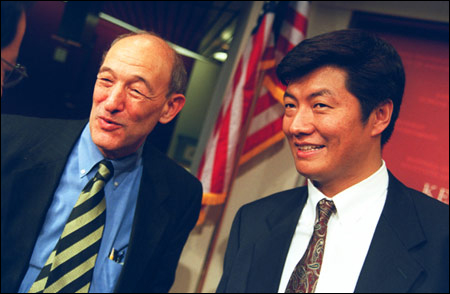Panel examines Beijing/Dalai Lama negotiations
Although some say tensions have abated, discussion proves situation is far from tractable

Twice this year, delegations representing the Dalai Lama have gone to Beijing to hold talks with officials of the Chinese government. Many have interpreted these discussions as a sign that tensions between Beijing and the Tibetan religious leader are easing, and that the next step may be a visit to China by the Dalai Lama himself.
On Nov. 21, a panel at the Kennedys School’s JFK Jr. Forum discussed the subject of “Negotiations Between the Dalai Lama and Beijing.” Two of the panel members were Tibetan and two Chinese. The moderator was Ezra Vogel, the Henry Ford II Research Professor of the Social Sciences and a noted authority on East Asia.
While none of the panel members spoke in an official capacity, their interaction suggested that while tensions may be easing, a real accord between China and Tibet’s government in exile is still some distance away.
“Right now, the Chinese government has all the cards. Time is on its side. It’s willing to listen, but not to all sorts of accusations and loose talk,” said Zheng Shiping, an associate professor of comparative politics and international relations at the University of Vermont. Born in China, Zheng earned his B.A. and M.A. degrees from Fudan University in Shanghai and a Ph.D. from Yale.
“I challenge the idea that time is on the side of the Chinese government,” said Lobsang Sangay, a Tibetan activist and scholar, currently an S.J.D. candidate (doctor of juridical science) at Harvard Law School. “That is based on the perception that when the Dalai Lama dies, these problems will be resolved, but I believe that with the passing of the Dalai Lama, Tibetans will become more radicalized.”
The Dalai Lama left his country in 1959 after China brutally squelched an uprising in Tibet. He now lives in Dharamsala in northern India. Speculations about what would happen after the Dalai Lama dies accelerated last year when rumors circulated that the 68-year-old leader had stomach cancer. The Dalai Lama has denied these rumors and reports that he is in good health.
One of the questions most at issue in the discussion was the extent to which Tibetans actually enjoy autonomy in what is officially designated by the Chinese as an autonomous region. Bhuchung Tsering, a Tibetan-born journalist who is currently director of the International Campaign for Tibet, said that lack of real freedom was obvious from the number of Tibetans crossing the border.
“Every year thousands of Tibetans flee to India. Why do they do this? The GNP is lower in India than in China. This is evidence that the Tibetan people don’t enjoy cultural freedom.”
Hu Xiaojiang, a Chinese-born lecturer in Harvard’s Sociology Department who has studied Tibet’s transitional economy, took exception to this assertion.
“A lot of people are also going back to Tibet. Also a lot of Tibetans use India as a jumping-off place to go to the United States to earn money,” she said.
Both Tibetan panel members emphasized that independence for Tibet was not an issue and hasn’t been since 1978 when former Chinese ruler Deng Xiaoping indicated that the problems of Tibet could be resolved if Tibetans stopped talking about independence.
“The Dalai Lama realized that the survival of the cultural identity of Tibet was more important than independence,” said Tsering. “This is the middle way approach.”
And yet there seemed to be some disagreement about where autonomy ended and independence began. Another issue was the fact that the boundaries of the Tibetan autonomous region do not include the entire Tibetan population, a situation that Sangay claimed was in violation of the Chinese constitution.
“The Chinese government feels that if this territory is given to Tibet, it will be used as a springboard for independence,” he said.
But when Vogel asked whether rearranging the boundaries to include Tibetans currently outside the autonomous region would be acceptable to China, Zheng replied, “I don’t think it would be possible to change the boundaries. It would just be a waste of time.”
“We should look at this issue from a different perspective,” said Tsering. “Let’s put the emphasis on the survival of the Tibetan people. I don’t see why this can’t be accommodated within Chinese limitations. To the Chinese, the idea of a ‘Greater Tibet’ seems very sinister. But the survival of the Tibetan people would be acceptable.”
Vogel asked whether the Dalai Lama’s position of relinquishing an independent Tibet in return for cultural and religious survival really had the support of Tibetans around the world. Sangay asserted that the Dalai Lama did represent the vast majority of Tibetans.
“Let the Tibetan people vote whether they accept the leadership of the Dalai Lama. I guarantee he would get 70, 80, or even 90 percent.”
But while Zheng did not dispute the Dalai Lama’s popularity, he said that he found the religious leader’s statements to be rather vague and expressed doubts about his effectiveness as a political leader.
“I think the Dalai Lama needs someone like a prime minister, someone to pay attention to details. He needs someone like a Henry Kissinger.”
Sangay replied by emphasizing the benefits that would accrue to the Chinese if they proved themselves willing to negotiate the conditions of Tibetan autonomy.
“If you resolve the dilemma, it will benefit China’s image. If a Chinese leader resolves the issue of Tibet and shows that China is changing, he may be the first Chinese to win the Nobel Peace Prize.”




